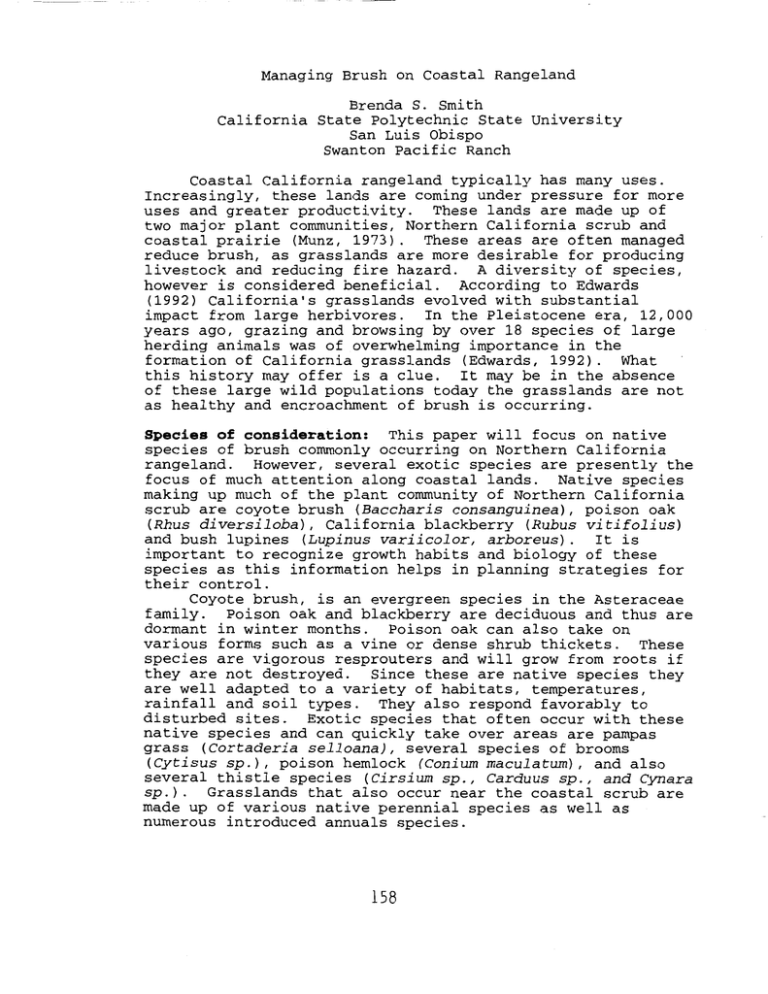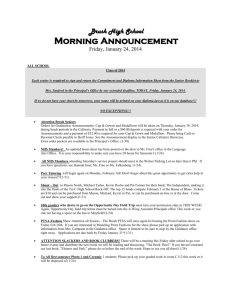Managing Brush on Coastal Rangeland Brenda S. Smith California
advertisement

Managing Brush on Coastal Rangeland
Brenda S. Smith
California State Polytechnic State University
San Luis Obispo
Swanton Pacific Ranch
Coastal California rangeland typically has many uses.
Increasingly, these lands are coming under pressure for more
uses and greater productivity. These lands are made up of
two major plant communities, Northern California scrub and
coastal prairie {Munz, 1973). These areas are often managed
reduce brush, as grasslands are more desirable for producing
livestock and reducing fire hazard. A diversity of species,
however is considered beneficial. According to Edwards
(1992) California's grasslands evolved with substantial
impact from large herbivores.
In the Pleistocene era, 12,000
years ago, grazing and browsing by over 18 species of large
herding animals was of overwhelming importance in the
formation of California grasslands {Edwards, 1992). What
this history may offer is a clue.
It may be in the absence
of these large wild populations today the grasslands are not
as healthy and encroachment of brush is occurring.
Species of consideration: This paper will focus on native
species of brush commonly occurring on Northern California
rangeland.
However, several exotic species are presently the
focus of much attention along coastal lands. Native species
making up much of the plant community of Northern California
scrub are coyote brush {Baccharis consanguinea), poison oak
(Rhus diversiloba), California blackberry {Rubus vitifolius)
and bush lupines {Lupinus variicolor, arboreus) .
It is
important to recognize growth habits and biology of these
species as this information helps in planning strategies for
their control.
Coyote brush, is an evergreen species in the Asteraceae
family.
Poison oak and blackberry are deciduous and thus are
dormant in winter months.
Poison oak can also take on
various forms such as a vine or dense shrub thickets. These
species are vigorous resprouters and will grow from roots if
they are not destroyed.
Since these are native species they
are well adapted to a variety of habitats, temperatures,
rainfall and soil types. They also respond favorably to
disturbed sites. Exotic species that often occur with these
native species and can quickly take over areas are pampas
grass (Cortaderia selloana), several species of brooms
(Cytisus sp.), poison hemlock (Conium maculatum), and also
several thistle species {Cirsium sp., Carduus sp., and Cynara
sp.).
Grasslands that also occur near the coastal scrub are
made up of various native perennial species as well as
numerous introduced annuals species.
158
Herbicide management options: A field study was conducted in
the spring of 1990 at the Swanton Pacific Ranch, north of
Santa Cruz. This experiment was primarily designed to
determine efficacy of several herbicides on poison oak.
However, coyote brush, California blackberry, bush lupine as
well as several exotic species were present in the test area.
Herbicides selective to broadleaves were chosen so as not to
damage the grasses in the area. All materials were applied
at 0.5% concentration at 200 gpa. Triclopyr ester and amine
formulations, dicamba, 2,4-D, and dicamba + 2,4-D premix and
triclopyr + 2,4-D all performed similarly. At 6 months af~er
treatment best results on poison oak were recorded.
Dicamba
provided 90% control, triclopyr up to 85% control and the
lowest control was from 2,4-D at 70%. The only significant
difference (LSD 0.05) in control was between the dicamba and
2,4-D treatments.
Regrowth was observed on all treatments and the plots
were re-treated 1 year after initial treatments.
Even though
the plants have been controlled, dead stems still remain in
the plots four seasons after application. A method to remove
the dead plants may need to be considered when determining if
herbicides are an option. Cost and restrictions of materials
may also be important factors in deciding on a herbicide
option to manage brush.
Use of livestock for managing brush: Over much of the
history of rangelands used for grazing, low populations of
animals have continuously grazing the land. This grazing
pattern typically creates a patchwork of overgrazed plants
next to undergrazed plants which favor the encroachment of
brush species.
In an attempt to change this grazing pattern,
a herd of 120 Spanish goats was brought to Swanton Pacific
Ranch in the fall of 1993. Spanish goats diets consist of up
to 70% of brush with the remainder in grasses (Univ. of CA,
1980). The main consideration in choosing goats for brush
management is they convert a previously unwanted plant into a
marketable product - they can be sold for meat.
Using these animals for brush management involves
intensive management. The herd is held in 2 to 4 acre areas
in a 4-wire electric fence. They are moved every 5 to 14 days
depending on the season. Water is brought to them with a
portable tank.
The animals and fence is checked every day.
In the past year, the animals dietary preferences have been
noted. When introduced to a new area, Coyote brush is most
readily eaten and the bark stripped from the stems, followed
by California blackberry. They less readily eat poison oak
or lupine.
They also browse poison hemlock and a variety of
thistle species. After browsing the brush species they will
forage on grass.
If young Monterey pines are in the
enclosure the goats will also readily strip the bark from the
trees. A llama provides protection from predators and no
animals have been lost to predation.
159
The grass in the browsed area is allowed a time to
recover and then cattle are grazed in the area. The cattle
continue to break down the now weakened brush species.
In
the past year, the brush has been observed to resprout up to
4 times after the goats have browsed.
Developing a management plan: As a recommendation, it is
important to realize no area is the same in terms of uses or
plant species. Therefore, it is imperative to develop a
specific land management plan to successfully manage brush on
coastal rangelands.
By answering such questions as "Why do
you want to control brush?, How much brush is present?, How
is the land used now? and How will the land use change after
the brush is controlled?" can guide land managers in
determining which methods or which combinations of methods
will bring the most success on their specific area. A long
term plan or strategy involving the integration of several
control options will most successfully limit the encroachment
of brush species and ultimately lead to healthier more
productive land.
References:
Edwards, $. W.
1992. Observations on the prehistory and
ecology of grazing in California. Fremontia. 20(1) :3-11.
Munz, P. A.
1973.
Press. Berkeley.
A California Flora. University of Calif.
University of Calif. 1980. Goats for California Brushland.
Leaflet 21044, U C Cooperative Extension. Davis.
160




